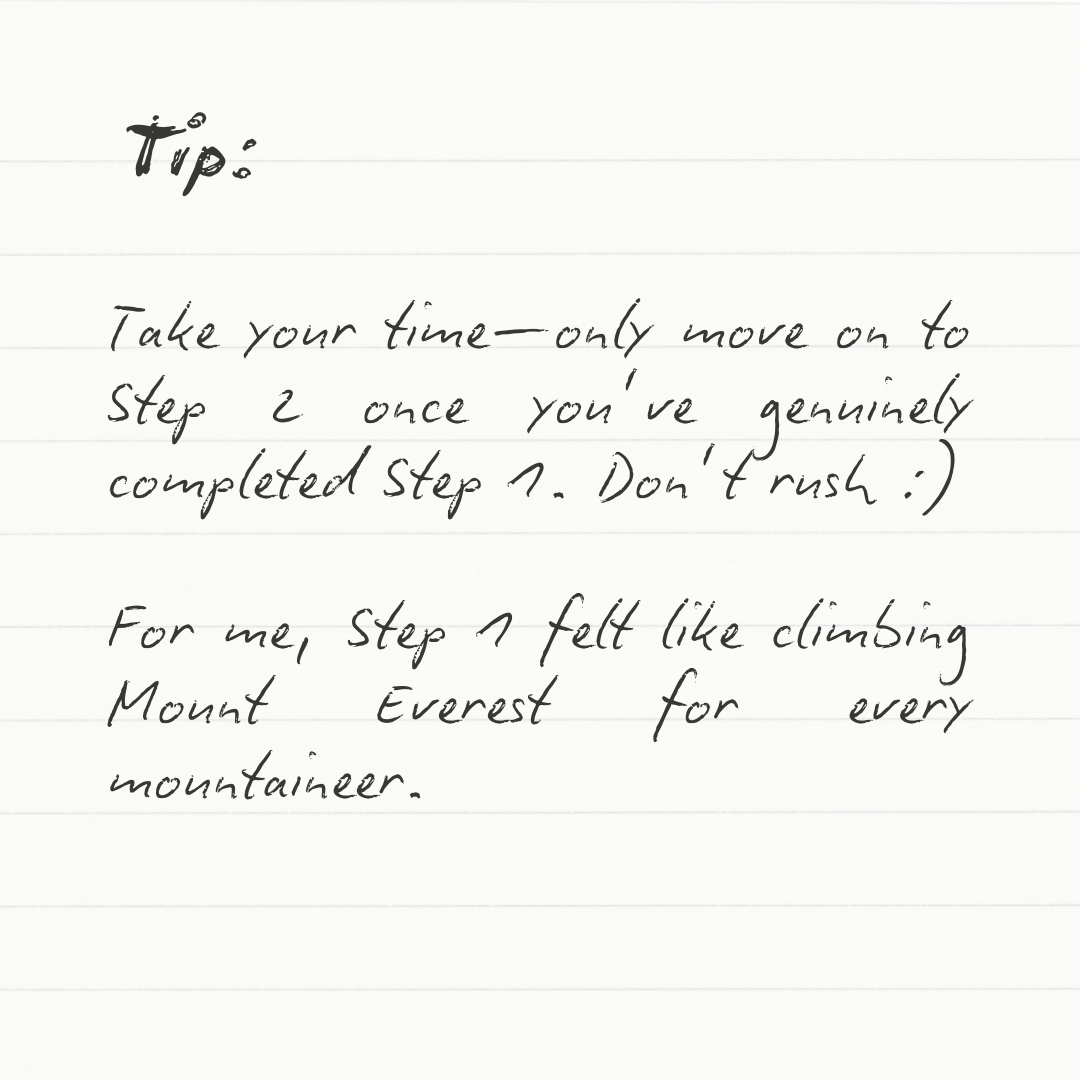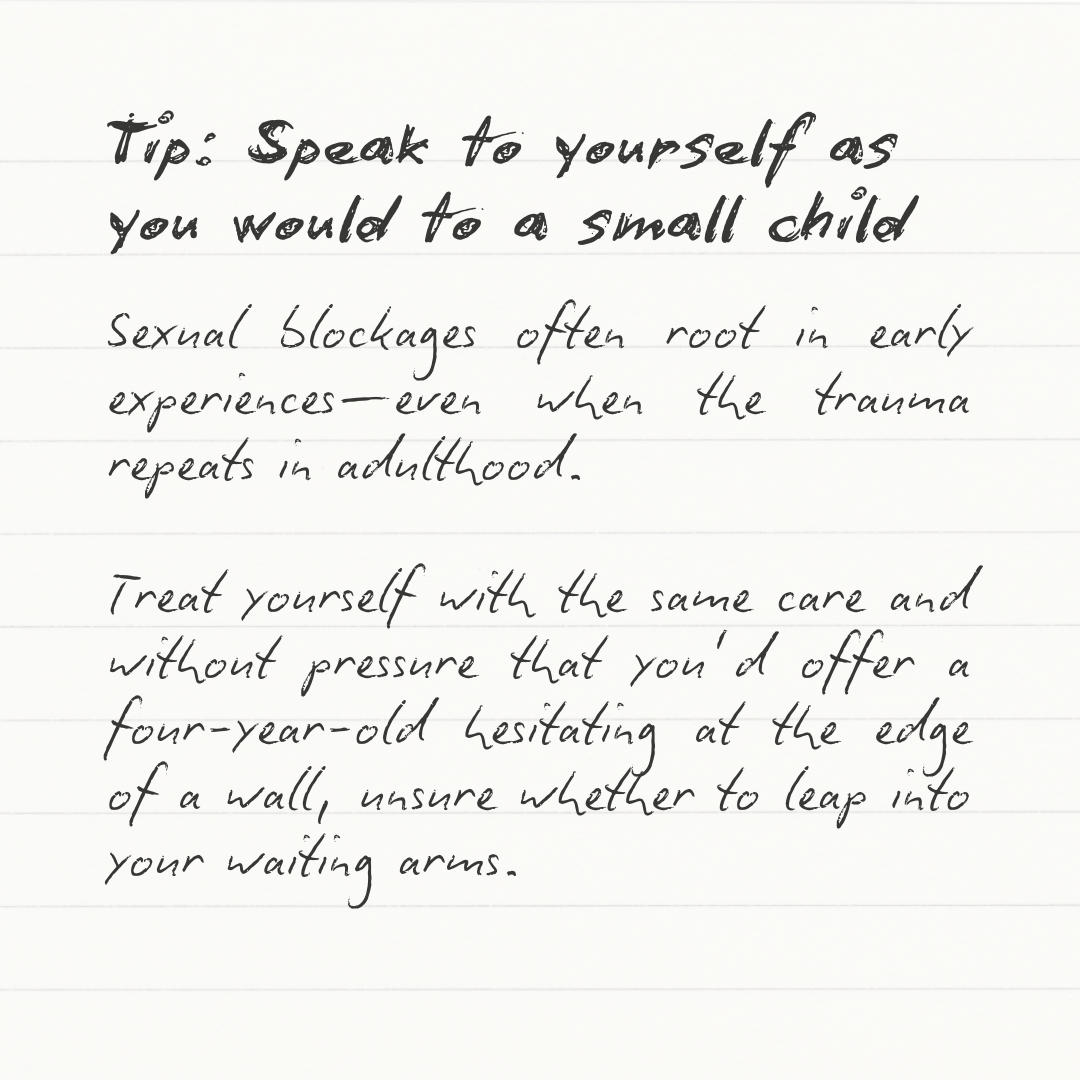Sexual Dissociation: When Sex Becomes a Performance and True Intimacy Is Missing
READING TIME: 9 MIN | PSYCHOEDUCATION | NOTES TO GROW
Do you ever feel empty after sex, wondering if your partner really enjoyed it—and whether you should have performed better?
That nagging doubt can stem from unconscious shame and dissociation from your own body and sexuality. In this article, I’ll give you an overview of what sexual dissociation is, how to recognize it, and the conditions and concrete steps that can guide you toward genuine intimacy.
Recognizing Dissociation—and Why Prince Charming Won’t Fix It
Many people with a history of sexual trauma unconsciously slip into a role meant to please their partner—in hopes of earning love and validation. If you feel empty afterwards, never reach orgasm (or have never had one), avoid self-stimulation or touch from others—your nervous system is likely retreating to protect you. This is actually a brilliant survival mechanism. But until you feel truly safe, real intimacy stays blocked—and your longing for connection remains out of reach.
-
Dissociation in this context means “switching off” internally when you experience closeness or touch—your body is there, but your feelings and presence are absent. Your nervous system creates an inner distance to shield you from overwhelm.
You might notice:
Physical numbness or emptiness despite external touch
Your mind wandering—you’re no longer mentally present
Fear and shame take center stage, while real desire and connection can’t surface
This is a natural protective function of your nervous system. By learning to re-engage in small steps and gently explore these defenses, you can gradually dissolve dissociation and allow true intimacy.
I’m sorry to disappoint you: the dream partner who falls so unconditionally for you that everything effortlessly “flows” will never arrive—because the block is within you, not them. Your fear of truly allowing touch is too great to let anyone in. You must first become your own rescuer—build a loving, trusting relationship with yourself so that your dream partner is permitted to love you, too. That emptiness, that lack of passion, that missing orgasm—it’s not your partner’s doing, it’s yours.
Signs of Sexual Dissociation
Fear of letting go
Physical emptiness or numbness during closeness
Lack of arousal despite stimulation
Avoidance of self-touch
Feeling like you’re “performing” instead of being authentic
Racing thoughts: “Did I do enough?”
Inability to stay present in the moment
What to do about it: How to get in touch with your body during Sex?
The gateway to your body is honest acknowledgment of what’s there:
“I feel sexually blocked.”
Notice what kind of sensations you feel. Like tightness, numbness, clenching or nothing. Where do you feel it specifically? In your gut, your stomach, your heart or chest, or even in your genital area. What kind of thoughts are coming in? That your body doesn’t match societal ideals or you feel pressured to “perform” in bed. Allow yourself to just acknowledge all of that:
“Yes, this is how it is right now.”
Then open up to the possibility that it can be different. Behind the blockade lies enormous potential: to experience trust and real intimacy. These moments act like a balm for body and soul—safe closeness releases healing hormones and boosts well-being. Connection is not a luxury; it’s a basic need that heals and sustains us.
Allow yourself to hold both your block and your need for closeness at once. The journey from dissociation and sexual withdrawal toward free sexuality and deep intimacy is a big leap—and for many people, a lifelong process. Below, we’ll explore the prerequisites and concrete steps that can support you on this creative path.
Building the Foundation: Your Safe Path to Closeness and Intimacy
Safety: Create a space—physical and emotional—where you feel protected. This could be an empathic therapist, an attentive friend, or a trusting loving partner. Notice fear and panic as guideposts: they show where your nervous system seeks protection.
Time: Healing is a process, not a goal. Give yourself as much time as you need to rediscover your sexual energy and connection to yourself. Patience is the key.
Relationship: Trauma results from a lack of connection, and therefore heals in connection. First, nurture your connection with yourself through self-care and compassion. Then choose, with care, who will accompany you. Mistakes will happen; allow forgiveness and learn from them. You need to learn who truly feels safe for you.
The Practice Path to Intimacy: Uncovering and Releasing Blocks
Once you’ve created a safe space and granted yourself time, you can—with or without a trusted companion—enter intimate, bodily contact step by step:
First Step: Arrive Slowly
Before physical intimacy, focus on the present: notice your breath, your heartbeat, how your chest rises and falls. Let thoughts float by without following them. If “just being” feels difficult, acknowledge that presence itself is a practice. A non-sexual massage or sound bath can help calm your nervous system. If relaxation doesn’t come immediately, that’s part of the process, not a failure.
Second Step: Allow Yourself to Feel
Move forward in tiny, safe steps until you notice more. Stay mindful if touches are too intense or too faint. A sudden drop in arousal or a strong trigger is not a setback, but a clear signal of your boundary. In fact, it’s part of the practice. Just return to the relaxation practice and take a break.
When your body and nervous system are ready, begin with light, slow touches—perhaps with a feather or your fingertips on your inner thighs, neck, face, or belly. Explore different areas and focus on the spots that feel especially pleasant. Linger there.
Allow yourself to savor the gentle tingling or warmth that sometimes spreads through your whole body. Sexual arousal doesn’t only happen in your genitals—before you explore “down there,” let your entire body come alive. Orgasm is merely the pinnacle of pleasure; you may need to start at the very subtle end of that spectrum.
For survivors of sexual trauma, this body-wide awakening can feel challenging, because the nervous system has been untrained.
So, ask yourself with curiosity and compassion:
How does my body feel right now?
Where do I notice warmth, tingling, or softness?
Where do I feel tightness, disgust, or tension?
If you feel nothing at all, treat it as a signal—for patience.
Continue in small, safe steps until you notice more.
Stay mindful: if a touch feels too much or too little, or if arousal suddenly drops, that’s not a failure but a clear signal of your boundary.
Respecting your boundaries is an important part of the practice! Just return to your relaxation exercise and give yourself a pause.
Third Step: Compassion - Celebrate Your Courage
At the end of your practice session, thank yourself:
“Thank you for being so brave. Thank you for connecting with me.”
Allow yourself to be proud of every attempt at contact. Tell yourself:
“Everything was right just as it was today. My courage counts.”
This small gesture of self-recognition strengthens your connection with yourself and lays the foundation for the next step on your path to sexuality and deep intimacy.
Key Takeaways
In this blog post, we explore the unconscious roles survivors of sexual trauma take on in intimate moments to feel loved and valued. This “performance mode” leads to sexual dissociation: feelings of emptiness, numbness, and shame block true intimacy and leave the longing for connection unfulfilled.
We’ve outlined that healing rests on three foundational elements:
We’ve sketched out a rough practice path:
Keep in mind: it’s a dance with your nervous system, not a race. Triggers and setbacks aren’t signs of failure but valuable signals of your boundaries.
With this roadmap—creating safety, practicing step by step, and honoring yourself—you open the path from blockade and dissociation to fulfilling intimacy and genuine connection.
Your Path to Greater Vitality – Take the First Step Now
The tips in this article are suggestions and do not replace professional therapy. If you need support, please seek qualified help—at specialized counseling centers or with me.
Having walked this path myself, I guide people with great care to rediscover their sexual energy, desire, and aliveness. Every journey is unique and can feel overwhelming or painful at first—yet it also brings immense gifts: increased creativity, renewed life force, deeper friendships, and more fulfilling intimate relationships.
Always with courage,
Lisa
Work With Me
If you’d like to walk this path with me, I offer guidance for at least six months—ideally a full year—with regular sessions.
Together, we’ll navigate the highs and lows and build a trusting relationship where true healing can take place.
Clarity begins with a conversation.








